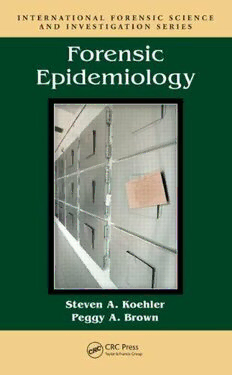
Forensic Epidemiology (International Forensic Science and Investigation) PDF
318 Pages·2009·3.2 MB·English
Most books are stored in the elastic cloud where traffic is expensive. For this reason, we have a limit on daily download.
Preview Forensic Epidemiology (International Forensic Science and Investigation)
Description:
After 9/11, the forensic epidemiology field emerged as a leading investigative tool, partnering public health officers with law enforcement like never before. Based on the authors’ first-hand experience, Forensic Epidemiology brings to light the vast amounts of information collected by medical examiners that will be useful in advancing death investigation techniques among the science, public health, and law enforcement fields. This practical resource begins with a brief overview of epidemiological science and the history of forensic epidemiology before examining the multiple functions of death certificates and the signature role of forensic epidemiologist’s in death investigations. Incorporating numerous illustrations and real-world examples, this book: Explains proven methods to collect, analyze, and interpret data for criminal investigations Defines the terminology, methodology, procedures, and goals of all branches involved for more effective collaboration Examines deaths from natural, suicidal, accidental, homicidal, and undetermined causes Describes the various decomposition states and methods used to establish positive identity The increased frequency of criminal acts that involve deliberate biological and chemical agents underscores the need for collaboration between those in public health and law enforcement investigators. Separately, the public health community and law enforcement agencies have a unique authority that the other does not. However, as Forensic Epidemiology effectively demonstrates, when these agencies work together, they can mount a powerful and successful response to threats on the American public.
See more
The list of books you might like
Most books are stored in the elastic cloud where traffic is expensive. For this reason, we have a limit on daily download.
